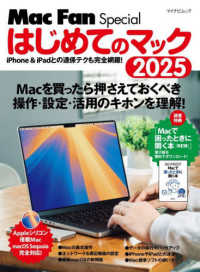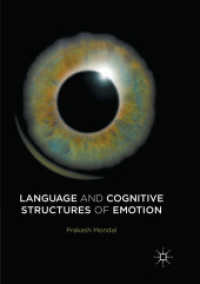Full Description
The new 12th edition of Scholastic Journalism is fully revised and updated to encompass the complete range of cross platform multimedia writing and design to bring this classic into the convergence age.
Incorporates cross platform writing and design into each chapter to bring this classic high school journalism text into the digital age
Delves into the collaborative and multimedia/new media opportunities and changes that are defining the industry and journalism education as traditional media formats converge with new technologies
Continues to educate students on the basic skills of collecting, interviewing, reporting, and writing in journalism
Includes a variety of new user-friendly features for students and instructors
Features updated instructor manual and supporting online resources, available at www.wiley.com/go/scholasticjournalism
Contents
About the authors xi
Preface xii
Acknowledgments xiii
Walk through xvi
Timeline xxii
1 Understanding news 3
Where does news come from? 6
News value 6
Timeliness 6
Proximity 7
Prominence 8
Audience impact 9
Surprise or oddity 10
Human interest 10
Conflict and drama 10
Visual impact 10
The importance of audience 11
Beat reporting 12
Featurizing news 15
News in other contexts 17
Sourcing news 17
Primary sources 17
Secondary sources 20
Other factors affecting coverage 22
Conclusion 25
2 Interviewing and reporting 29
Interviewing 30
Developing questions 31
Organizing the interview 32
Setting up the interview 32
Conducting the interview 33
Observation 40
Reliability of sources 42
Internet research 44
Conventional research 47
Conclusion 48
3 News writing 51
News writing 52
The news lead 54
Alternative news lead approaches 55
Feature leads 59
Contrast lead 59
Vignette lead 61
The descriptive lead 62
Developing a news story 63
Body of a news story 66
Flow and organization 69
Potential weaknesses in news writing 69
Vagueness 69
Wordiness 71
Jargon and pretentious vocabulary 71
Editorializing 72
Numerical distortions 72
Passive voice 74
Online news coverage 74
Using quotes and attribution 75
A news writer's checklist 75
Conclusion 77
4 Writing specialty stories 81
Health writing 82
Academic writing 85
Death coverage 87
Speech stories 87
Poll story 94
Selecting respondents 94
Civic journalism 97
Yearbook writing 99
Unique story angles 101
Alternative copy or sidebar writing 101
Conclusion 106
5 Writing feature stories 111
The feature story Idea 112
The feature-writing process 113
Conclusions 116
Elements of feature writing 116
Precise writing 117
Details 117
Pace 118
Examples 118
Dialogue 118
Voice 118
Feature story types 124
Profiles 124
Human interest story 126
Informative feature story 130
Other types of features 131
Conclusion 132
6 Sportswriting 139
Writing the sports story 140
Sports slang and sports language 141
Developing a sports story with statistics 142
Types of sports stories 143
Advance story 143
Trend story 145
Sports news story 146
Game story 146
Sports feature story 151
Feature leads for sports stories 152
Packaged coverage 154
Sports webcasting 155
Getting started 155
The webcast staff 156
Conclusion 158
7 Opinion writing 165
Developing editorial ideas 168
Role of the editorial 168
Opinion vs. fact 169
Editorial writing: the formula 169
Editorial leads 170
Developing the argument 172
Editorial cartoon 172
Columns 175
Blog writing 176
Review writing 178
Reviewing tips 178
Packaged opinion coverage 183
Conclusion 183
8 In-depth reporting 189
Finding topics for in-depth coverage 192
School governing boards 193
Athletics 193
Curricular areas 193
Extracurricular and other areas 194
Beyond the school 195
Localizing national and state trends 195
Getting started 198
Full-page coverage 198
Double truck coverage 200
Beyond the double truck 200
Special issues 203
The yearbook 203
Writing the in-depth story 204
Anonymous sources 209
Layering information 211
The need for accuracy 211
Conclusion 211
9 Coaching writers and editing copy 215
The coaching process 216
Planning stage 216
Collecting stage 216
Writing stage 217
The lead 217
Body organization and flow 217
Proofreading and correcting a story 218
Fact check 218
Clarity and conciseness 220
Detail 220
Common editing mistakes 225
Using journalistic style 226
Names and identification 226
Capitalization 227
Abbreviations 228
Numbers 229
Punctuation 229
Italics 232
Computer-related terms 232
Spelling 232
Screening sexist language 234
Problem words 236
Race, ethnicity and other terms of identity 236
Coaching writing continues 237
Conclusion 237
10 Writing headlines 245
Headlines: the basics 246
Teaser and teller headlines 246
Getting the words to fit 246
News website headlines 248
The appearance of headlines 248
Writing a headline 250
Writing a teller 250
Headline construction rules 253
Feature headlines 255
Conclusion 258
11 Typography and production 263
Type: the basics 264
Type terms 265
Categories of type 267
Choosing type 272
Factors to consider 272
Contrast and creativity 274
Consistency 277
Production and printing 281
Digital toning for printing 281
Printing 283
Conclusion 286
12 Newspaper layout and design 291
The importance of design 292
Changes in news presentation 292
Elements of design 292
Information packaging 301
Grid and column considerations 301
Modular design 306
Preparing for design 306
Special considerations for design 310
Using color effectively 317
Pacing the newspaper's design 317
Conclusion 319
13 Yearbook design 323
Speaking the language 324
Getting ready to design 327
Designing the pages 331
Special considerations 335
DVD and interactive coverage 341
The use of color 343
Conclusion 343
14 Online journalism 347
Creating web publications 348
Website hosting and privacy policies 350
Assembling a publication website 351
Creating online content 353
Multimedia content 354
Involving the readers 358
Enhanced yearbook content 360
Design of the website 361
Cooperative efforts 368
Conclusion 368
15 Visual storytelling: pictures, art and graphics 371
The importance of visuals 372
Photographs 374
Technical parameters 374
Content and composition 375
Telling stories through images 380
Picture packages or groups 380
Picture stories 381
Digital shooting 384
Lenses 384
Flash 386
Camera bodies 387
Captions and cutlines 387
Cropping photographs 389
Photo editing 389
Abuse of images 391
Photo alteration 396
Art and illustrations 396
Information graphics 400
Other graphic forms 400
Conclusion 401
16 Advertising in newspapers and yearbooks 405
Creating an advertising program 406
Preparation 406
Advertising policy 409
Business knowledge 411
Preparing for the sales call 411
The sales call 411
Telephone sales 414
Creating an advertisement 414
Define the message 414
Creating the advertisement, one step at a time 417
Some other considerations in ad design 418
Conclusion 421
17 Student press law 427
Who, what, where, when and how - and student press law 428
The law 428
The First Amendment 430
Unprotected speech 431
The Supreme Court and speech in school 436
Tinker 437
Fraser 438
Morse 438
Hazelwood 439
Post-Hazelwood cases 442
Conclusion 448
18 Ethics for student journalists 451
What is ethics? 452
Ethics, the law and the First Amendment 452
Media ethics 453
Newsgathering ethics 454
Publishing ethics 456
Post-publication ethics 457
Common ethical issues journalists face 458
Quotes 458
Anonymity and confidentiality 459
Conflicts of interests 460
Crimes, victims and the suspect 460
Photo integrity 461
Using someone else's photographs or artwork 461
Ethical lapses - gaffes, quandaries and journalistic felonies 461
Fabrication 462
Plagiarism 463
Lies, deception and undercover reporting 463
Stolen materials and unauthorized access 464
Identification of groups/stereotyping/sexist/racist/personal details 464
News vs. opinion 464
Obscenity, profanity and vulgarity 464
Web reporting 464
Journalism codes of ethics 467
Conclusion 467
19 Careers in the media 471
Studying media in high school 472
After high school 474
After college 475
Advertising 475
Public relations 476
News organizations 476
Magazines 477
Multimedia photography 478
Wire services 480
Broadcasting 482
Freelancing 482
Other opportunities 482
Conclusion 483
Professional and student organizations 485
Glossary 488
Index 498








